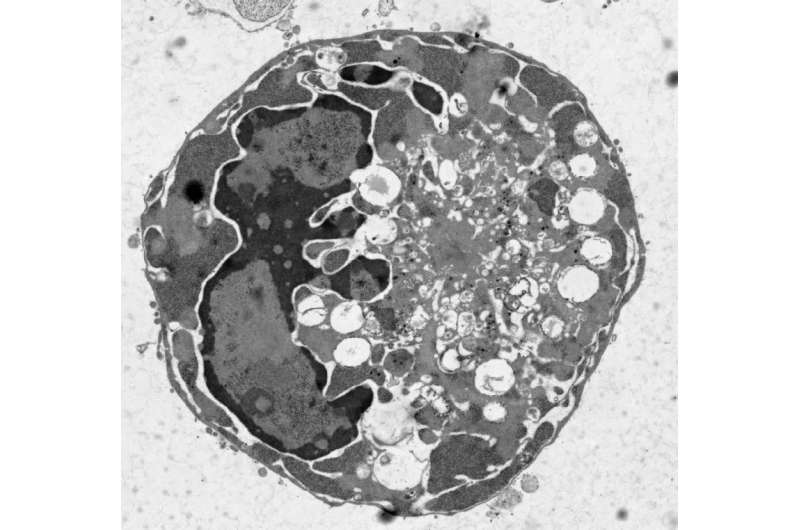Cold-adapted attenuated polio virus—towards a post-eradication vaccine

With only 74 cases reported worldwide in 2015, poliomyelitis eradication is in sight. However, polio vaccines will be required for the foreseeable future to prevent re-emergence of the disease, and such vaccines need to be safe, effective, cheap, and easy to deliver. A study published on March 31, 2016 in PLOS Pathogens reports the generation of promising new cold-adapted vaccine strains that are unable to multiply at the temperature of the human body and therefore highly unlikely to cause poliomyelitis in humans.
To minimize the risks associated with post-eradication vaccine manufacturing, stockpiling, and delivery, WHO and its collaborators would like to see conventional inactivated polio vaccine (cIPV, which is made from polio virus strains that, before they are inactivated, can cause poliomyelitis) replaced with an IPV made from attenuated (non-disease-causing) polio strains. Barbara Sanders, from Janssen Infectious Diseases and Vaccines in Leiden, The Netherlands, and colleagues set out to develop novel attenuated polio virus strains. Their goal was to develop strains for affordable IPV manufacture that can address the biosafety issues of cIPV without compromising its high immunogenicity (i.e., the ability to induce a strong and lasting immune response).
The researchers' approach was to attenuate polio virus by adapting it to grow below the 37°C (98.6 degrees Fahrenheit), the normal body temperature for humans. They then looked for strains that would grow well at lower temperatures, were unable to grow at 37°C or higher, and could induce potent antiviral immunity after being inactivated.
The researchers started by selecting virus strains that grew well at low temperature (26-30°C) in a cell line suitable for vaccine manufacture. After several rounds of selection, they isolated three different virus clones and sequenced their genomes. Each clone had acquired multiple mutations, and the researchers then used genetic engineering to combine a total of 31 mutations from the three clones into one synthetic viral genome. The resulting virus grew well at 30°C but was completely unable to grow at 37°C.
Next, they then combined this virus with genes from cIPV viruses that code for the virus outer shell and are responsible for generating a strong and polio-specific immune response. Like the parental strains, these CAVA (for Cold-Adapted Viral Attenuation) viruses were unable to grow at 37°C, and they maintained this absolute temperature block even after prolonged time in the 37°C environment. In contrast, the CAVA strains grew well at 30°C in the vaccine manufacture cell line, suggesting that they could be produced at low cost for an affordable vaccine.
To demonstrate that the viruses could not cause disease in warm-blooded animals, the researchers injected them directly into the brains of mice that were genetically altered to be susceptible to polio. None of the mice injected with the CAVA strains became paralyzed, whereas all of the control animals that were injected with cIPV viruses developed poliomyelitis.
The researchers next purified and inactivated a small batch of CAVA viruses under conditions resembling those required for human vaccine manufacture, and showed that these inactivated CAVA viruses were capable of inducing a potent immune response in rats.
"The unprecedented temperature sensitivity of the CAVA strains is characterized by an inability to replicate at 37°C and capacity to propagate to high titers at 30°C", the researchers summarize, "[which] translated to a high level of in vivo neuroattenuation and suggests that the CAVA strains are non-infectious at physiological temperature".
Acknowledging that "further work is required to demonstrate equivalent immunogenicity" (of the new strains compared with the current cIPV ones), the researchers nonetheless hope that, together with their highly productive cell line platform, the CAVA strains "may serve as an attractive low-cost and (bio)safe option for the production of a next generation IPV which can aid in achieving and maintaining a polio free world".
More information: Sanders BP, de los Rios Oakes I, van Hoek V, Bockstal V, Kamphuis T, Uil TG, et al. (2016) Cold-Adapted Viral Attenuation (CAVA): Highly Temperature Sensitive Polioviruses as Novel Vaccine Strains for a Next Generation Inactivated Poliovirus Vaccine. PLoS Pathog 12(3): e1005483. DOI: 10.1371/journal.ppat.1005483




















